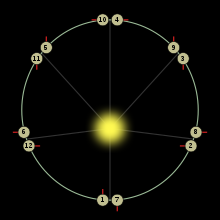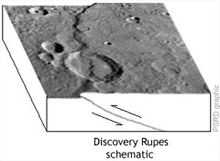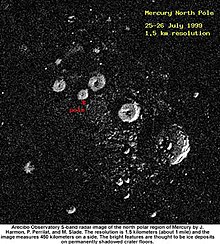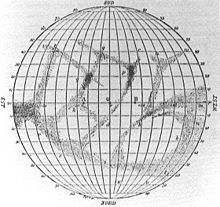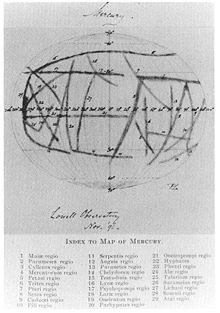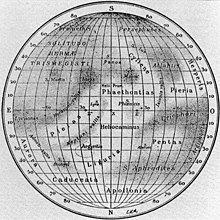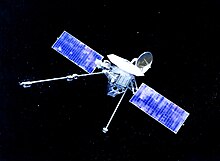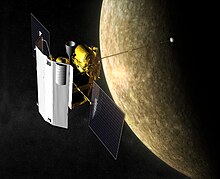Mercury (planet)
| Mercury |
|
|---|---|
| Mercury in natural colors as the Messenger space probe approaches | |
| Properties of the orbit | |
| Major semi-axis | 0.3871 AU (57.909 million km) |
| Perihelion - aphelion | 0.3075 - 0.4667 AU |
| eccentricity | 0.2056 |
| Inclination of the orbit plane | 7.0049 ° |
| Sidereal period | 87,969 days |
| Synodic period | 115.88 days |
| Mean orbital velocity | 47.36 km / s |
| Smallest - largest distance to earth | 0.517-1.483 AU |
| Physical Properties | |
| Equatorial diameter * | 4,879.4 km |
| Pole diameter * | 4,879.4 km |
| Dimensions | ≈0.055 earth mass 3.301 · 10 23 kg |
| Medium density | 5.427 g / cm 3 |
| Gravitational acceleration * | 3.70 m / s 2 |
| Escape speed | 4.3 km / s |
| Rotation period | 58 d 15 h 36 min |
| Inclination of the axis of rotation | 0.034 ° |
| Geometric albedo | 0.142 |
| Max. Apparent brightness | −2.43 m |
| Pressure * | <5 · 10 −15 bar |
|
Temperature * min. - average - max. |
100 K (−173 ° C ) 440 K (+167 ° C) 700 K (+427 ° C) |
| * based on the zero level of the planet | |
| Others | |

|
|
| Size comparison between Mercury (left) and Earth | |
The Mercury has a diameter of nearly 4,880 kilometers, the smallest, with an average distance from the sun of about 58 million kilometers of the sun next and thus fastest planet in the solar system . With a maximum daytime temperature of around +430 ° C and a night temperature of −170 ° C, it has the largest surface temperature fluctuations of all planets.
Due to its size and chemical composition, it is one of the Earth-like planets .
Because of its proximity to the sun, it is difficult to observe from Earth , as it only reaches a maximum angular distance of about 28 ° from the sun . It can only be seen with open eyes for a maximum of one hour either in the evening or in the morning sky , but telescopically during the day as well . Details on its surface can be seen from a telescope opening of about 20 cm .
Mercury is named after the messenger of the gods Mercurius , the Roman god of merchants and thieves. Its astronomical symbol is ☿.
Celestial mechanics
Orbit
As the planet closest to the Sun, Mercury has the shortest orbital time of just under 88 days on an orbit with the major semi-axis of 0.387 AU (57.9 million km) - with an average distance to the center of the sun of 0.403 AU (60.4 million km) . With a numerical eccentricity of 0.2056, Mercury's orbit is more elliptical than that of any of the other major planets in the solar system. Its point closest to the sun, perihelion , is 0.307 AU (46.0 million km) and its point furthest from the sun, aphelion , is 0.467 AU (69.8 million km). Likewise, the inclination of its orbital plane with respect to the earth's orbital plane is 7 ° greater than that of all other planets. Such a high eccentricity and orbit inclination are otherwise more typical for dwarf planets like Pluto and Eris .
Perihelion
Newtonian mechanics already predicts that the gravitational influence of the other planets disrupts the two-body system Sun-Mercury. Due to this disturbance, the major axis of Mercury's orbit executes a slow right-hand rotation in the orbit plane. Strictly speaking, Mercury does not go through an elliptical, but a rosette orbit . In the second half of the 19th century , astronomers were able to measure these changes, particularly the position of the Mercury perihelion, with great accuracy. Urbain Le Verrier , then director of the Paris Observatory, noted that the precession (rotation) of the perihelion for Mercury is 5.74 ″ ( arcseconds ) per year. However, this value could not be fully explained with the classical mechanics of Isaac Newton . According to Newtonian celestial mechanics, it should be only 5.32 ″, the measured value is 0.43 ″ too large per year, the error is 0.1 ″ (or 29 km) per revolution. Therefore, in addition to the causing flattening of the sun, it was assumed that there was also an asteroid belt between Mercury and the sun or another planet, which should be responsible for these disturbances.
Although a name had already been chosen for this supposed planet - volcano -, despite an intensive search, no object could be found within Mercury's orbit. Since an object in this area can easily be outshone by it due to the correspondingly small distance to the sun, the problem aroused only moderate interest until Albert Einstein, with his general theory of relativity, provided an explanation for the systematic deviation between the calculated and the observed orbit. The relativistically calculated surplus of 43.03 ″ (uncertainty: 0.03 ″) per century agrees well with the observed difference of 42.96 ″ (uncertainty: 0.94 ″). For a complete perihelion rotation of 360 °, Mercury needs around 225,000 years or around 930,000 orbits and thus experiences a perihelion that is rotated by around 1.4 ″ for each orbit.
Possible future development
Konstantin Batygin and Gregory Laughlin from the University of California, Santa Cruz, and independently Jacques Laskar from the Paris Observatory, have determined through computer simulations that the inner solar system is not stable in the long term. In the distant future - in a billion years or more - Jupiter's gravitational pull could tear Mercury out of its current orbit by gradually increasing Mercury's great orbital eccentricity until the planet crosses the orbit of Venus at its furthest point from the sun .
There could then be four scenarios: Mercury crashes into the sun; he is hurled out of the solar system; it collides with Venus or with the earth . However, the likelihood that one of these possibilities will occur before the sun swells into a red giant is only around 1%.
| Comparison of the distances from Earth, Venus and Mercury to the Sun: |
rotation
The axis of Mercury's right-hand rotation is almost perpendicular to its plane. That is why there are no seasons with different day lengths on Mercury. However, solar radiation varies considerably due to the eccentricity of the orbit: In perihelion, about 2.3 times as much energy from the sun hits the surface of Mercury as in aphelion. This effect, which is small on earth because of the low eccentricity of the orbit (7%), leads to seasons on Mercury.
Radar observations in 1965 showed that the planet does not have a simple bound rotation , as originally assumed by Giovanni Schiaparelli in 1889 , that is, the sun always faces the same side (just as the Earth's moon always shows the same side). Rather, as a special feature, it has a broken-bound rotation and rotates exactly three times around its axis during two revolutions. Its sidereal rotation period is 58.646 days, but due to the 2: 3 coupling to the rapid orbital motion with the same direction of rotation, Mercury day - the time interval between two sunrises at any point - on the planet with 175.938 days also corresponds exactly to the period of two Orbits of the sun. After another orbit, the sun rises accordingly at the antipode . If Mercury passes through the point closest to the Sun in its rather strongly eccentric orbit, the perihelion, the central star, for example, is always alternately above the Caloris basin at 180 degrees of longitude or above its chaotic antipodal region at the prime meridian at the zenith . During Mercury's highest orbital speeds in the perihelion area, the angular speed of its orbital movement is greater than that of its rotation, so that the sun in the Mercury sky performs a retrograde loop movement.
To explain the coupling of rotation and orbit, a mass concentration similar to the so-called Mascons of the large, approximately circular Maria of the Earth's moon is assumed under Caloris Planitia (the "hot" lowland) , where the tidal forces of the sun cause the presumably faster self-rotation of Mercury have slowed down this unusual response .
Planet without a moon
Mercury has no moon . The existence of such a thing was never seriously considered. However, since the mid-1960s there has been the hypothesis by various scientists that Mercury itself was once a moon of Venus. Initially only a few peculiarities of its orbit gave cause for the assumption. Later, its special rotation and the surface shape of two strikingly different hemispheres, analogous to the Earth's moon, were added. This assumption can also explain why the two planets are the only ones in the solar system to be moonless.
On March 27, 1974, it was believed to have discovered a moon around Mercury. Two days before Mariner 10 passed Mercury, the probe began to measure strong UV emissions, which disappeared shortly afterwards. Three days later, the emissions reappeared, but appeared to be moving away from Mercury. Some astronomers suspected a newly discovered star, others a moon. The speed of the object was calculated to be 4 km / s, which roughly corresponded to the expected value of a Mercury moon. Some time later, the object was finally identified as Star 31 Crateris .
construction
Outwardly, Mercury resembles the planetologically and geologically inactive Earth's moon , but the inside apparently corresponds much more to that of the geologically very dynamic Earth.
the atmosphere
Mercury does not have an atmosphere in the conventional sense, because it is thinner than a vacuum that can be achieved in a laboratory , similar to the atmosphere of the moon. The “atmospheric” constituents hydrogen H 2 (22%) and helium (6%) most likely come from the solar wind , whereas oxygen O 2 (42%), sodium (29%) and potassium (0.5%) probably come from the Material of the surface were released (the percentages are imprecise estimates for the volume fractions of the gases). The pressure of the gas envelope is only about 10 −15 bar on the floor of Mercury and the total mass of Mercury's atmosphere is only about 1000 kilograms.
Due to the high temperatures and the low attraction of Mercury can not last long, the gas molecules, they escape through photoevaporation always friendly to all . In relation to the earth, the area for which this applies is called the exosphere ; it is the exchange zone with interplanetary space. An original atmosphere as a degassing product of the planet's interior has long been lost to Mercury; there are no traces of an earlier erosion by wind and water . The lack of a proper gas envelope, which would ensure a certain leveling of surface temperatures, causes extreme temperature fluctuations between the day and night side in this proximity to the sun. Compared to the night temperatures, which drop to −173 ° C, the side of the planet illuminated during the smallest distance from the sun is heated up to +427 ° C. During the greatest distance from the sun, the highest ground temperature with the great orbital eccentricity of Mercury is still around +250 ° C.
surface
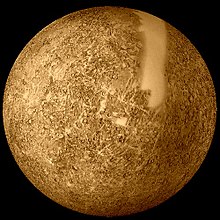
Because of the difficult accessibility in the orbit near the Sun and the associated danger from the more intense solar wind, only two space probes , Mariner 10 and Messenger , have so far visited the planet and studied it in more detail. In three flybys in the 1970s, Mariner 10 was only able to map about 45% of its surface. The Mercury probe Messenger had also photographed some areas not covered by Mariner 10 on its first flyby in January 2008 and was able to increase the coverage to around 66%. With their second swing-by in October 2008, coverage increased to around 95%.
The moon-like surface, interspersed with craters , made of rough, porous, dark rock reflects the sunlight only weakly. The mean spherical albedo is 0.06, which means that the surface scatters back an average of 6% of the light arriving from the sun practically parallel . This means that Mercury is on average a little darker than the moon (0.07).
On the basis of the destructive impairment of the surface structures among each other, as with the moon and Mars , a reconstruction of the chronological order of the formative events is possible. There are no signs of plate tectonics in the imaged areas of the planet ; Messenger has found numerous indications of volcanic eruptions .
crater

| Surname | throughput knife |
Coordinates |
|---|---|---|
| Rembrandt | 716 km | 32.89 ° S; 272.13 ° W |
| Beethoven | 630 km | 20.81 ° S; 123.90 ° W |
| Sanai | 490 km | 13.46 ° S; 006.68 ° W |
| Anairin | 467 km | 27.33 ° S; 002.50 ° W |
| Dostoevsky | 430 km | 44.87 ° S; 177.24 ° W |
| Shakespeare | 399 km | 48.00 ° N; 152.25 ° W |
| Tolstoy | 356 km | 16.24 ° S; 164.66 ° W |
| Raphael | 342 km | 20.40 ° S; 076.31 ° W |
| Homer | 319 km | 01.26 ° S; 036.58 ° W. |
| Goethe | 317 km | 81.10 ° N; 051.03 ° W |
The surface of Mercury is littered with craters. The distribution of impact structures is more even than on the moon and Mars; accordingly, the age of its surface is consistently very high. One of the reasons for the high density of craters is the extremely thin atmosphere, which allows small bodies to penetrate unhindered . The large number of craters per area - a measure of the age of the crust - speaks for a very old surface, that is, since the formation and solidification of Mercury from about 4.5 to about 4 billion years ago, the surface has not changed much.
As with the moon, Mercury's craters show another feature that is typical of a structure created by impact: the material that has been thrown out and fallen back and piles up around the crater; sometimes in the form of radial rays, also known as ray systems on the moon. Both these spoke-like rays and the central craters from which they emanate are brighter than the surroundings due to their relatively young age. The first observations of the rays of Mercury were made with the Arecibo and Goldstone radio telescopes and with the Very Large Array (VLA) of the United States National Radio Observatory (see also Astrogeology ). The first crater detected by the Mariner 10 spacecraft during its first approach was the 40 km wide, but very bright, radiation crater Kuiper (see picture on the right). The crater was named after the Dutch-American lunar and planetary researcher Gerard Kuiper , who was part of the Mariner 10 team and who died before the probe arrived.
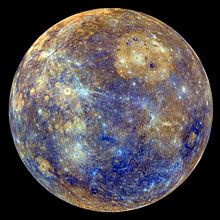
North of the equator is Caloris Planitia, a huge, circular but fairly shallow basin. With a diameter of about 1550 km, it is the largest known structure on Mercury. It was probably created around 3.8 billion years ago by an impact body over 100 km in size. The impact was so violent that the seismic vibrations around the location of the impact raised several concentric ring walls and lava emerged from the interior of the planet. The volcanic structures newly discovered by Messenger can be found especially in the surroundings and also inside the basin. The interior of the basin has apparently been filled up by the magma from the depths, similar to the mare basins of the moon. The bottom of the basin is shaped by many concentric furrows and ridges that are reminiscent of a target and give it a resemblance to the approximately comparable large multi-ring system on the moon, in whose center the Mare Orientale is located. The rather shallow Caloris Basin is bounded by the Caloris Montes , an irregular chain of mountains whose summit heights only reach about 1 km.
Levels
Other shallow plains also resemble Mary of the Moon. Mare (plural: Maria, German 'seas') is in Selenology - the "geology" of the earth's satellite - the Latin generic name for the smooth and dark basalt surfaces that fill numerous craters and basins of the moon as a result of solidified lava that has risen from the ground . The smooth planes of Mercury are not dark like the "lunar seas". Overall, they are also apparently smaller and less numerous. They are all located in the northern hemisphere in the vicinity of the Caloris Basin. Their generic name is Planitia, Latin for plain.
The fact that the mare-like planes on Mercury do not stand out from their surroundings with a darker color like the Maria of the Moon is explained by a lower content of iron and titanium . However, this results in a certain contradiction to the high mean density of the planet, which speaks for a relatively very large metal core, which consists mainly of iron. Messenger found dark soils in the Caloris Basin only as a filling of smaller craters, and although a volcanic origin is assumed for their material, the measurement data, unlike what is to be expected for such rock, also show only a very small proportion of iron. The metal is contained in Mercury's surface to a maximum of 6 percent.
particularities
Two formations can only be found on the surface of Mercury:
- First, a peculiarly chaotic-looking terrain, irregularly shaped, up to about 1 km high hills, which is cut by valleys, which is exactly opposite the Caloris basin. The cause of the formation is assumed to be a bundling of the seismic oscillations of the great impact, which destroyed the original relief of the antipodal region . The affected area is around five times the size of Germany and is therefore at least the same size as the Caloris Basin, which has only been explored by around a third.
- Second, steep steps up to several hundred kilometers long, which have the greatest differences in altitude (2 km) on Mercury. In astrogeology, these structures are called rupes (Latin for embankment , steep wall). They wind gently across plains and craters. These are crust thrusts. The laterally shifted parts of the crater indicate that they were also shifted horizontally against each other. These thrusts are believed to have resulted from the entire planet shrinking.
The American geologist Robert G. Strom, distinguished in planetary geology , estimated the extent of the shrinkage of Mercury's surface to be around 100,000 km². This corresponds to a reduction in the planet's radius by up to about 2 km. More recent estimates, which are largely based on the measurements of the Messenger space probe , come to a significantly higher value of around 7 km of contraction.
The cause of the contraction is seen as the cooling of the planet following a hot phase of its formation, in which, like the earth and the moon, it is said to have been heated up to the point of glowing liquid by many large asteroid impacts. This phase of development only ended about 3.8 billion years ago with the “ Last Heavy Bombardment ”, during which the crust could slowly cool down and solidify. Some of the lobed embankments were apparently partially destroyed again by the end of the bombing. This means that they are correspondingly older than the respective craters. The time of Mercury shrinkage is assumed on the basis of the degree of space erosion - through many smaller, subsequent impacts - about 4 billion years ago, i.e. during the formation of the mare-like plains.
According to an alternative hypothesis, the tectonic activities during the contraction phase can be traced back to the tidal forces of the sun, through whose influence the rotation of Mercury was slowed down from an unbound, higher speed to the current period of rotation. This is supported by the fact that these structures, as well as a number of gullies and ridges, extend more in a meridional than in an east-west direction.
After the contraction and the corresponding solidification of the planet, small cracks appeared on the surface, which overlapped with other structures such as craters and the flat plains - a clear indication that the cracks are of more recent origin than the other structures. The time of volcanism on Mercury ended when the compression of the shell set in, so that the exits of the lava on the surface were closed. Presumably this happened during a period which is classified between the first 700 to 800 million years of the history of Mercury. Since then, there have only been isolated impacts from comets and asteroids .
Another special feature compared to the relief of the moon are the so-called intermediate crater planes on Mercury. In contrast to the lunar surface, which is also saturated with larger craters, on Mercury there are relatively smooth plains with a highland character between the large craters, which are characterized by relatively few craters with diameters of less than 20 km. This type of terrain is most common on Mercury. Some researchers see this as the original, relatively unchanged surface of Mercury. Others believe that very early and large-scale volcanism once smoothed the regions. There are signs that the remnants of larger and also many double ring walls like those of the moon are still faintly visible in these planes.
Possibility of the presence of ice and small organic molecules
For the polar regions of Mercury, the results of radar studies allow the possibility that small amounts of water ice could exist there. Since Mercury's axis of rotation at 0.01 ° is practically perpendicular to the plane of the orbit, the interior of some near-polar craters is always in shadow. In these areas of eternal night, permanent temperatures of −160 ° C are possible. Such conditions can preserve ice, e.g. B. was introduced by impacted comets. The high radar reflections can, however, also be caused by metal sulfides or by the alkali metals or other materials detected in the atmosphere .
Measurements published by the Messenger space probe in November 2012 indicate water ice inside craters at Mercury's north pole that is constantly in shadow. Traces of organic molecules (simple carbon and nitrogen compounds) were also found. Since these molecules are considered to be the basic prerequisites for the creation of life, this discovery aroused some astonishment, as this was not thought possible on the atmospheric planet that was intensely heated by the sun. It is believed that these traces of water and organic matter were brought in by comets that struck Mercury.
Evidence in detail
The radio waves emitted by the Goldstone radio telescope on NASA Deep Space Network had an output of 450 kilowatts at 8.51 gigahertz ; the radio waves received by the VLA with 26 antennas made bright spots appear on the radar screen, spots suggesting depolarized reflections of waves from the north pole of Mercury.
The studies made with the Arecibo radio telescope, which emitted waves in the S-band (2.4 GHz) with a power of 420 kW, made it possible to draw a map of the surface of Mercury with a resolution of 15 km Has. In these studies, not only could the already found zones of high reflection and depolarization exist, but a total of 20 zones at both poles. The expected radar signature of ice is increased reflection and greater depolarization of the reflected waves. Silicate rock, which makes up the largest part of the surface, does not show this.
Other methods of examining the rays reflected back to Earth suggest that these zones are circular in shape and therefore could be craters.
At the south pole of Mercury, zones of high reflection appear to coincide with the Chao Mang-Fu crater and small areas in which craters have also been identified.
The situation at the North Pole is a little more difficult because the radar images do not seem to match those of Mariner 10. It therefore stands to reason that there may be zones of high reflection which cannot be explained by the existence of craters.
The reflections of the radar waves that the ice creates on the surface of Mercury are less than the reflections that could be created with pure ice; possibly it is due to the presence of dust that partially covers the surface of the crater.

Nomenclature of the surface structures
In the planetary nomenclature of the IAU, the following conventions are defined for the designation of surface structures on Mercury:
| Generic name |
Description of the structure | current number with name |
Area from which the names come | IAU list |
|---|---|---|---|---|
| Catena | Chain of craters | 3 | Radio telescope systems | planetarynames.wr.usgs.gov |
| Crater | almost circular structure that is believed to be an impact crater |
372 | visual artists, musicians and writers (deceased for at least 50 years) |
planetarynames.wr.usgs.gov |
| Dorsum | Terrain ridge | 2 | scientists deserving of the exploration of Mercury | planetarynames.wr.usgs.gov |
| Fossa | long, narrow and shallow depression | 1: Pantheon Fossae | significant structures | planetarynames.wr.usgs.gov |
| Mons | mountain | 1: Caloris Montes | Words for "hot" in different languages | planetarynames.wr.usgs.gov |
| Planitia | low lying plain | 7th | Names for Mercury (planet or god) in different languages | planetarynames.wr.usgs.gov |
| Rupes | Steep slope or steep step | 30th | Ships of explorers or scientific expeditions | planetarynames.wr.usgs.gov |
| Vallis | Valley, shallow depression | 5 | abandoned ancient settlements and cities | planetarynames.wr.usgs.gov |
For the 32 named albedo formations - areas with special reflectivity - a large part of the names from Eugène Michel Antoniadi's Mercury mapping was adopted.
internal structure
Mercury is a rocky planet like Venus , Earth and Mars and is the smallest of them all in the solar system. At 4878 km, its diameter is only 40 percent of the diameter of the earth. It is even smaller than Jupiter's moon Ganymede and Saturn's moon Titan , but each more than twice as massive as these very ice-rich satellites.
The diagram shows how much the mean density of the earth-like planets including the earth's moon increases with the diameter in general with a similar chemical composition. Mercury, however, has a density of 5.427 g / cm³, which is almost the same as that of the much larger earth and is therefore far above the diameter-density ratio of the others for its size. This shows that it must have a “heavier” chemical composition: Its very large iron-nickel core is said to consist of 65 percent iron, make up about 70 percent of the planet's mass and have a diameter of about 3,600 km. The latest measurements even show a core diameter of 4100 km, that would be three quarters of the planet's diameter, the core would be larger than the Earth's moon. The mantle of silicate, which is only 600 km thick, accounts for around 30 percent of the mass, compared to 62 percent for the earth. The crust is relatively thick with a few 10 km and consists mainly of feldspar and minerals of the pyroxene group , so it is very similar to terrestrial basalt . The slightly higher overall density of the earth results from the more compressive effect of its strong gravity.
The cause of the high iron content
Mercury's relative iron content is greater than that of any other large object in the solar system. Various hypotheses are put forward as an explanation, all of which are based on a previously more balanced shell structure and a correspondingly thicker, low-metal shell:
One theory assumes that Mercury originally had a metal- silicate ratio similar to that of chondrites , the most common class of meteorites in the solar system. Its initial mass should therefore have been around 2.25 times its current mass. However, in the early days of the solar system, around 4.5 billion years ago, Mercury was - so it is speculated - hit by a very large asteroid with about a sixth of this mass. An impact of this magnitude would have torn away much of the planet's crust and mantle, leaving only the metal-rich core. A similar explanation has been proposed for the formation of the Earth's moon as part of the collision theory . In the case of Mercury, however, it remained unclear why so little of the shattered material fell back onto the planet. According to computer simulations from 2006, this is explained by the effect of the solar wind, by which many particles were blown away. Of these particles and meteorites that did not fall into the sun, most of them escaped into interstellar space and 1 to 2 percent got to Venus and around 0.02 percent to Earth.
Another theory suggests that Mercury formed very early in the evolution of the solar system, before the energy radiation of the young sun had stabilized. This theory also assumes that the original mass of the innermost planet is about twice as large. When the protostar began to contract, temperatures between 2500 and 3500 K ( Kelvin ), possibly even up to 10,000 K, could have prevailed on Mercury . Some of its matter would have evaporated at these temperatures and would have formed an atmosphere that was swept away by the solar wind over time.
A third theory argues similarly and assumes a long-lasting erosion of the outer layers of the planet by the solar wind.
According to a fourth theory, shortly after its formation, Mercury was grazed by one or more protoplanets that were twice to four times as heavy as it was - and in the process it lost large parts of its rock mantle.
Magnetic field
Despite its slow rotation, Mercury has a magnetosphere the volume of which is about 5 percent of the Earth's magnetosphere. With an average field intensity of 450 nanotesla on the surface of the planet, it has about 1 percent of the strength of the earth's magnetic field . The inclination of the dipole field against the axis of rotation is around 7 °. The orientation of the magnetic poles corresponds to the situation on earth, which means that, for example, the magnetic north pole of Mercury lies in the vicinity of its southern axis of rotation. The limit of the magnetosphere in the direction of the sun is only at an altitude of about 1000 kilometers, which means that high-energy particles of the solar wind can reach the surface unhindered. There are no radiation belts . Overall, Mercury's magnetic field is asymmetrical. It is stronger in the northern hemisphere than in the southern hemisphere, so that the magnetic equator is around 500 kilometers north of the geographic equator. This makes the southern hemisphere easier to reach for the solar wind.
Mercury's dipole field may be generated by the dynamo effect of circulating melts in the metal core, very similar to that of the earth ; then its field strength would have to be 30 times stronger than measured by Mariner 10. According to a model calculation (Ulrich Christensen 2007 at the Max Planck Institute for Solar System Research Katlenburg-Lindau), large parts of a fluctuating field created inside are strongly dampened by electrically conductive and stable layers of the outer, liquid core, so that only a relatively weak field remains.
Actually, due to its small size - like the much larger and already solidified Mars - Mercury should have cooled down too much since its formation to be able to keep iron or an iron- nickel mixture liquid in its core . For this reason, a hypothesis was set up which explains the existence of the magnetic field as a remnant of an earlier, but now extinct dynamo effect ; it would then be the result of solidified ferromagnetites . However, it is possible that, for example, a eutectic alloy with a lower melting point could be formed through mixtures with sulfur . Using a special evaluation process, a team of American and Russian planetary researchers led by Jean-Luc Margot from Cornell University were able to use radar waves to investigate the rotation of Mercury from Earth more precisely and determine pronounced fluctuations with a magnitude of 0.03 percent speak clearly for a partially melted interior.
Development stages
According to the conventional theory of the formation of the sun's planetary system, Mercury, like all planets, emerged from a gradual agglomeration of planetesimals , which united to form larger and larger bodies. In the last phase of accretion the larger bodies swallowed the smaller ones and in the area of today's Mercury orbit the planet closest to the Sun was formed within about 10 million years.
With the heating of the protoplanet, i.e. the “raw planet”, through the decay of the radioactive elements and through the energy of many large and continuous impacts while the smaller chunks were being picked up, what can be described as geological development due to the lack of a Mercury-specific term . The body, heated to the point of embers, differentiated itself chemically into core, mantle and crust through its internal gravity. With the end of the continuous bombardment, the resulting planet could begin to cool down, and a solid rock crust formed from the outer layer.
In the following stage all craters and other traces of the fading accretion appear to have been covered. The cause could have been a period of early volcanism. The formation of the intermediate crater levels and the formation of the lobed slopes due to the shrinking of Mercury are assigned to this time.
The end of the heavy bombardment was impressively reflected in the emergence of the Caloris Basin and the associated landscape forms in the relief as the beginning of the third epoch.
In a fourth phase (probably due to another period of volcanic activity) the vast, mare-like plains were created.
The fifth phase of surface design, which has been ongoing for around 3 billion years, is only characterized by an increase in impact craters. The central craters of the radiation systems are assigned to this time, the striking brightness of which is regarded as a sign of freshness.
The sequence of events in general bears a surprisingly great resemblance to the history of the surface of the moon; In view of the unequal size, the very different locations in the solar system and the associated different conditions, this was not to be expected.
exploration
Mercury has been known at least since the time of the Sumerians (3rd millennium BC). The ancient Greeks gave it two names, Apollo when it heralds the sun in the morning sky and Hermes when it chases after the sun in the evening sky.
However, the Greek astronomers knew that it was the same celestial body. According to unclear sources, Herakleides Ponticus may even have believed that Mercury and Venus orbit the sun and not the earth . In 1543, Nicolaus Copernicus published his work De revolutionibus orbium coelestium (Latin: on the revolutions of the heavenly circles ), in which he arranged the planets according to their speed in circular orbits around the sun, which means that Mercury was closest to the sun.
The Romans named the planet after Mercurius, the winged messenger of the gods, because of its rapid movement in the sky .
Earthbound exploration
The orbit of Mercury has long been a problem for astronomers. Copernicus wrote about this in De revolutionibus : "The planet tormented us with many puzzles and great hardship when we explored its wanderings" . In 1629 Johannes Kepler succeeded for the first time in predicting a so-called Mercury transit for November 7, 1631 (to an accuracy of about half a day) with the help of observational data from his predecessor Tycho Brahe . When Pierre Gassendi was able to observe this passage in front of the sun, he established that Mercury did not measure a fifteenth of the sun's diameter, as estimated by Ptolemy in the 2nd century, but was many times smaller.
After the invention of the telescope, Giovanni Battista Zupi discovered in 1639 that Mercury shows phases like the moon, thus proving its orbit around the sun. When Sir Isaac Newton published the Principia Mathematica in 1687 and thus described gravitation, the planetary orbits could now be calculated exactly. Mercury, however, always deviated from these calculations, which prompted Urbain Le Verrier (who discovered the planet Neptune ) in 1859 to postulate another even faster planet closer to the Sun: Vulcanus . Only Albert Einstein's theory of relativity was able to correctly explain these deviations in Mercury's orbit.
The first, only very vague maps of Mercury were sketched by Johann Hieronymus Schroeter . The first more detailed maps were made in the late 19th century, by Giovanni Schiaparelli around 1881, and then by Percival Lowell . Lowell believed that, like Schiaparelli, he could see canals on Mercury during his Mars observations. Better, albeit still very imprecise, was the map of Mercury by Eugène Michel Antoniadi from 1934. Antoniadi started from the common but erroneous assumption that Mercury has a bound rotation of 1: 1 around the sun. For his nomenclature of the albedo characteristics he referred to the Hermes mythology. Audouin Dollfus took it over for the most part for his more accurate map from 1972. The International Astronomical Union (IAU) approved this nomenclature for today's Mercury maps on the basis of close-up exploration. A different scheme was chosen for the topographical structures. This is how the plains similar to Mary of the Moon got the name of the god Mercury in different languages.
In the coordinate system of Mercury, longitudes from east to west are measured between 0 and 360 °. The prime meridian is defined by the point at which the sun was at its zenith on Mercury's first perihelion after January 1, 1950 . The latitudes between 0 ° and 90 ° are counted positive to the north and negative to the south .
Rocks from Mercury that were thrown into space by the impact of larger asteroids can also reach Earth as meteorites over time. The enstatite chondrite Abee and the achondrite NWA 7325 are discussed as possible mercury meteorites .
Exploration with space probes
Mercury is one of the least explored planets in the solar system . This is mainly due to the very inhospitable conditions for space probes in the vicinity of the sun, such as the high temperature and intense radiation, as well as numerous technical difficulties that have to be accepted when flying to Mercury. Even from an earth orbit, the observation conditions are too unfavorable to observe the planet with telescopes . The mirror of the Hubble Space Telescope would be seriously damaged by the radiation of the sun if it were aimed at an area so close to the sun.
Mercury's mean distance from the Sun is a third of that of Earth, so that a space probe has to fly over 91 million kilometers into the sun's gravitational potential to reach the planet. From a stationary starting point, the spacecraft would not need any energy to fall in the direction of the sun. However, since the start takes place from Earth, which moves around the sun at an orbital speed of 30 km / s, the high orbital angular momentum of the probe prevents it from moving towards the sun. Therefore, the spacecraft has to produce a considerable change in speed in order to enter a Hohmann orbit that leads close to Mercury.
In addition, the decrease in the potential energy of the space probe during a flight into the sun's gravitational potential well leads to an increase in its kinetic energy , i.e. an increase in its flight speed. If this is not corrected, the probe is already so fast when it reaches Mercury that a safe entry into Mercury orbit or even a landing will be made considerably more difficult. For a flyby, however, the high airspeed is of less importance. Another obstacle is the lack of an atmosphere; this makes it impossible to use fuel-efficient aerobraking maneuvers to reach the desired orbit around the planet. Instead, the entire braking impulse for entry into Mercury orbit must be generated by the on-board engines using an extra amount of fuel.
These limitations are one of the reasons why Mercury before Messenger was only explored with the Mariner 10 space probe . A third Mercury probe BepiColombo was launched on October 20, 2018.
Mariner 10
The trajectory of Mariner 10 was chosen in such a way that the probe first approached Venus , then took a swing-by maneuver in the area of attraction for Mercury. So it came to a Mercury orbit around the sun, which could only be reached in this way with an Atlas Centaur launch vehicle ; Without the swing-by on Venus, Mariner 10 would have needed a much larger and more expensive Titan IIIC . The mathematician Giuseppe Colombo , who had long been interested in the exploration of the innermost planet, had designed this trajectory on which Mercury could be passed several times, always in the vicinity of its orbit point furthest from the sun - where the impairment from the solar wind is least - and at the same orbit of Mariner 10, which is also closest to the sun. The initially unforeseen consequence of this celestial mechanical three-body interaction was that the orbital period of Mariner 10 was exactly twice as long as that of Mercury. With this orbital property, the space probe got one and the same hemisphere under the same lighting conditions in front of the camera during every encounter and thus provided vivid evidence of the exact 2: 3 coupling of Mercury's rotation to its orbital movement, which, according to the first, approximate radar measurements, Colombo itself had already suspected. Due to this strange coincidence, only 45 percent of the surface of Mercury could be mapped, despite the repeated flyby.
Mariner 10 flew by Mercury three times from 1974 to 1975: on March 29, 1974 at a distance of 705 km, on September 21 at around 50,000 km and on March 16, 1975 at a distance of 327 km. In addition to the conventional images, the planet was examined in infrared and UV light, and measurements of the magnetic field and charged particles detected by the probe were taken over its night side, which shields the disturbing solar wind, during the first and third flyby.
Messenger
Another NASA space probe, Messenger , was launched on August 3, 2004 and was the first space probe to enter Mercury orbit in March 2011 in order to study the planet with its numerous instruments in detail and to map it completely for the first time. The space probe was dedicated to studying the geological and tectonic history of Mercury and its composition. The probe also searched for the origin of the magnetic field, determined the size and condition of the planet's core, examined the polar caps of the planet and explored the exosphere and the magnetosphere. In order to achieve his goal, Messenger flew a very complex route that first took him back to Earth in several fly-by maneuvers, then twice past Venus and three times past Mercury. The first flyby of Mercury took place on January 14th, 2008 at 8:04 pm CET and the second on October 6th, 2008. Examinations of the surface were already carried out and photos of previously unknown areas were taken. The third flyby, which reduced the speed of the probe, took place on September 30, 2009. As the probe unexpectedly switched to safe mode shortly before the passage, no observation data could be collected and transmitted for a long time. The entire trip took about 6.5 years. The mission in Mercury orbit is divided into annual sections, each beginning on March 18th. From March 18, 2011 to March 18, 2012, the most important researches were carried out during the so-called primary mission; then the first extended mission began, which ran until March 18, 2013. The mission was then extended again to March 2015. Towards the end of the mission, the probe was placed in orbits around the planet, the lowest point of which was just 5.3 km above the surface. The remaining fuel for the probe's engines was used to counteract the braking effect of the weak, but still existing, atmosphere. The last of these course corrections took place on March 25, 2015. On April 30, 2015, the probe then crashed on the far side of Mercury.
BepiColombo
The European space organization ESA and the Japanese space agency JAXA are exploring the planet closest to the Sun with the combined Mercury probe BepiColombo . The joint venture is named after the nickname of Giuseppe Colombo, who died in 1984, and consists of two orbiters deployed separately at the target: a remote sensing orbit for a 400 km × 1500 km polar orbit and a magnetospheric orbiter for a polar orbit of Mercury 400 km × 12,000 km. The components will each be dedicated to the study of the magnetic field and the geological composition in terms of the history of Mercury. The probe launched on October 20, 2018, its journey to Mercury will be supported with ion thrusters and fly-bys of the inner planets and is scheduled to enter orbit in 2025. At the target, the probe will be exposed to temperatures of up to 250 ° C and is expected to provide data for at least one year (i.e. over four Mercury years).
observation
Always close to the sun
As the innermost planet of the solar system, Mercury can only move away from the sun up to a maximum angle of 28 degrees ( greatest elongation ) and is therefore difficult to observe. At dusk or dawn, it can be seen with the naked eye as an orange point of light with an apparent brightness of around 1 mag to a maximum of −1.9 mag near the horizon . During daytime observations , it can be easily recognized from a telescope opening of around 10 to 20 cm , depending on the visibility .
The proximity to the horizon makes observing it with telescopes very difficult, as its light has to travel a greater distance through the earth's atmosphere and is disturbed by turbulence, refraction and absorption . The planet usually appears as a faded, crescent-shaped disc in the telescope. Even with powerful telescopes, you can hardly make out any distinctive features on its surface.
Since Mercury's orbit is strongly elliptical, the values of its greatest elongation fluctuate between the individual orbits from 18 to 28 degrees.
When observing Mercury - with the same geographic north or south latitude - the observers from the northern hemisphere are at a disadvantage, because the Mercury elongations with the greatest values take place at times when the ecliptic is flat above the horizon for an observer in the northern hemisphere and Mercury rises or sets in the bright twilight. In the latitudes of Central Europe, it cannot be seen with the naked eye. The best visibility promises maximum westerly elongation (morning visibility) in autumn and maximum easterly elongation (evening visibility) in spring.
At high above the horizon, Mercury can only be seen with the naked eye during a total solar eclipse .
Because of the great inclination of the orbit, the planet only passes in front of the solar disk every few years (see next section). On the other hand, it can sometimes become double-sighted precisely because it can be observed with the naked eye both in bright morning and bright dusk . This is possible in the days around the lower conjunction , when it does not just pass the sun, but up to 8 ° north of it.
Mercury transit
Due to the orbital properties of Mercury and Earth, similar Visibilities of Mercury repeat every 13 years. During this period, two so-called transits or passages generally take place, during which Mercury can be seen as a black disk directly in front of the solar disk when viewed from Earth . Such a transit of Mercury is visible when in the lower conjunction - while it overtakes the earth in its orbit around the sun on its inner orbit - it stands near one of its two orbit nodes , i.e. crosses the plane of the earth's orbit. Due to the corresponding geometry, such an event is only possible between May 6th and 11th or between November 6th and 15th, since the two orbital nodes on May 9th or November 11th are before the Stand in the sun. The last passage through Mercury took place on November 11, 2019 , the next will follow on November 13, 2032.
visibility
The following table shows the special constellations of Mercury for 2020. Eastern elongation provides evening visibility, western elongation provides morning visibility:
| Greatest eastern elongation |
Stationary, is going down |
Lower conjunction |
Stationary, becomes clockwise |
Greatest western elongation |
Upper conjunction |
||
|---|---|---|---|---|---|---|---|
| February 10, 2020 | 18.2 ° | February 16, 2020 | February 26, 2020 | March 9, 2020 | March 24, 2020 | 27.8 ° | 4th May 2020 |
| 4th June 2020 | 23.6 ° | 17th June 2020 | July 1, 2020 | July 12, 2020 | July 22, 2020 | 20.1 ° | 17th August 2020 |
| October 1, 2020 | 25.8 ° | October 14, 2020 | October 25, 2020 | 3rd November 2020 | November 10, 2020 | 19.1 ° | December 20, 2020 |
Cultural history

In ancient Egyptian mythology and astronomy , Mercury was mainly considered the star of Seth . His name Sebeg (also Sebgu ) stood for another form of the ancient Egyptian gods Seth and Thoth . In ancient Greece , the planet was related to the god and messenger of the gods Hermes , but was also associated with the titans Metis and Koios . The particularly restless planet, mostly only at dusk and then difficult to discover, was also seen as a symbol for Hermes as the patron saint of traders, highwaymen and thieves.
Among the Romans, at the latest in the post-ancient times, Hermes corresponded to Mercury , derived from mercari (Latin for trade ). The weekday they named after Mercury, this Mercurii, is Wednesday in German . In the assignment of the days of the week, Mercury's name is still associated with Wednesday in French (mercredi) , Italian (mercoledì) , Spanish (miércoles) , Romanian (miercuri) and Albanian (e mërkurë) . The Teutons are assigned the god Odin or Wotan as the equivalent of the star , to whom Wednesday (in English wednesday , in Dutch woensdag ) was assigned.
In ancient times and in the world of medieval alchemists, moving mercury was assigned to the hasty wandering star as the planetary metal . In many languages, the name of the metal is still based on this root word (English mercury , French mercure ).
Reception in literature, film and music
In music, Gustav Holst dedicated the third movement to Mercury in his orchestral suite The Planets, 1914–1916: Mercury, the Winged Messenger (Mercury, the winged messenger).
In popular literature , Isaac Asimov wrote the science fiction novel Lucky Starr and the Big Sun of Mercury for his Lucky Starr series in 1956 . It starts a project on the planet of hostile temperature extremes for new energy generation and transport methods for the earth's growing energy needs, which are, however, affected by sabotage. The German edition first appeared in 1974 under the title Im Licht der Merkur-Sonne .
In the film Sunshine , released by director Danny Boyle in 2007, an orbit around Mercury serves as a stopover for a spaceship whose cargo is supposed to keep the sun from going out.
The novel 2312 by Kim Stanley Robinson , published in 2012, is about the same year 2312, including in Mercury's capital Terminator , which is constantly moving on rails along the equator and is suddenly attacked with targeted meteoroids .
See also
literature
- Lexicon of Astronomy. 2 volumes. Herder, Freiburg / Basel / Vienna 1989, ISBN 3-451-21632-9 .
- ABC lexicon astronomy . Spectrum Academic Publishing House, Heidelberg / Berlin / Oxford 1995, ISBN 3-86025-688-2 .
- David Morrison: Planetary Worlds . Spectrum Academic Publishing House, Heidelberg / Berlin 1999, ISBN 3-8274-0527-0 .
- Planets and their moons . Spectrum Academic Publishing House, Heidelberg / Berlin 1997, ISBN 3-8274-0218-2 .
- NASA's Atlas of the Solar System . Knaur, Munich 2002, ISBN 3-426-66454-2 .
- Holger Heuseler, Ralf Jaumann, Gerhard Neukum : Between Sun and Pluto . BLV, Munich / Vienna / Zurich 1999, ISBN 3-405-15726-9 .
- Edward J. Tarbuck, Frederick K. Lutgens: Ciencias de la Tierra. Una Introducción a la Geología Física . Prentice Hall, Madrid 2000, ISBN 84-8322-180-2 .
- Hielo en Mercurio. In: Joan Pericay: EL Universo. Enciclopedia de la Astronomía y el Espacio. Volume 5. Editorial Planeta-De Agostini, Barcelona 1997, pp. 141-145.
- Stardate, Guide to the Solar System . University of Texas at Austin McDonald Observatory publication , OCLC 48099283 .
- Our Solar System, A Geologic Snapshot . NASA (NP-157). May 1992.
Web links
- NASA: Mariner 10 images of Mercury (English)
- NASA: Mercury Atlas (English)
- Solar System Exploration: Mercury. In: NASA.gov. (English).
- Solarviews: Mercury
- JA Dunne, E. Burgess: The voyage of Mariner 10: Missions to Venus and Mercury , Prepared by Jet Propulsion Laboratory, California Institute of Technology, 1978, (NASA-SP-424 )
- Merton E. Davies, Stephen E. Dwornik, Donald E. Gault, Robert G. Strom: Atlas of Mercury , Prepared for the Office of Space Sciences, National Aeronautics and Space Administration Scientific and Technical Information Office, 1978, (NASA-SP- 423) (English)
- Raumfahrer.net: Messenger discovers water ice on Mercury
- scinexx.de: Inner core is solid April 18, 2019
media
- Have we forgotten the planet Mercury? from the alpha-Centauri television series(approx. 15 minutes). First broadcast on Apr 11, 1999.
Individual evidence
- ^ A b c David R. Williams: Mercury Fact Sheet. In: NASA.gov. September 27, 2018, accessed May 9, 2020 .
- ^ Solar System Exploration: Planet Compare. In: NASA.gov. Retrieved May 9, 2020 .
- ↑ Gerald Maurice Clemence: The relativity effect in planetary motions . In: Reviews of Modern Physics . tape 19 , no. 4 , 1947, pp. 361 , doi : 10.1103 / RevModPhys.19.361 ( online [PDF; accessed on April 18, 2011]).
- ↑ Ken Croswell: Will Mercury Hit Earth Someday? Sky and Telescope, April 24, 2008, accessed October 6, 2008 .
- ↑ Worlds in collision. Spaceflight now, October 2, 2008, accessed October 6, 2008 .
- ↑ Stars and Space. 1/2010, pp. 22-24.
- ^ G. Colombo: Rotational Period of the Planet Mercury. nature, November 8, 1965, accessed October 6, 2009 .
- ↑ Simon Mitton: Cambridge Encyclopedia of Astronomy . Urania Verlag , Munich 1989, ISBN 3-572-03667-4 .
- ↑ Leonid V. Ksanfomaliti: planet. News from our solar system. MIR Moscow publishing house, Urania-Verlag Leipzig, Jena, Berlin, 1985, pp. 38-40.
- ↑ M. Yes. Marow : The planets of the solar system. (= Small Natural Science Library. Volume 60). MIR Moscow publishing house, BSB BG Teubner Verlagsgesellschaft, Leipzig 1987, ISBN 3-322-00316-7 , p. 55.
- ↑ Hypothetical Planets - Mercury's Moon, 1974. Retrieved September 28, 2014 .
- ↑ a b Tilmann Althaus: News from Merkur. astronomie-heute.de, July 3, 2008, accessed October 6, 2009 .
- ↑ a b Stefan Deiters: 95 percent of Mercury is photographed. astronews, October 31, 2008, accessed October 6, 2009 .
- ^ Official list of Mercury craters in the USGS Gazetteer of Planetary Nomenclature (English); accessed on September 28, 2014.
- ↑ Volcanoes boil on Mercury. In: Spiegel online. July 4, 2008, accessed October 6, 2009 .
- ↑ PK Byrne, C. Klimczak, AMC Şengör, SS Solomon, TR Watters, SA Hauck II: Mercury's global contraction much greater than earlier estimates. In: Nature Geoscience. 2014. doi: 10.1038 / ngeo2097
- ↑ David J. Lawrence et al .: Evidence for Water Ice Near Mercury's North Pole from MESSENGER Neutron Spectrometer Measurements. In: Science. 339, 2013, p. 292, doi: 10.1126 / science.1229953 .
- ^ Gregory A. Neumann et al .: Bright and Dark Polar Deposits on Mercury: Evidence for Surface Volatiles. In: Science. 339, 2013, p. 296, doi: 10.1126 / science.1229764 .
- ^ Categories for Naming Features on Planets and Satellites
- ^ Naming Albedo Features on Mercury
- ↑ Rainer Kayser: Mercury has a larger iron core than expected ( Memento from November 4, 2012 in the Internet Archive ). In: Wissenschaft aktuell. March 23, 2012.
- ↑ David E. Smith, Maria T. Zuber et al: Gravity Field and Internal Structure of Mercury from MESSENGER. In: Science. Volume 336, No. 6078, pp. 214-217. doi: 10.1126 / science.1218809
- ↑ Mercury . nineplaneten.de
- ↑ jme / dpa: Young solar system: Mercury was created by a grazing shot. In: Spiegel online. July 7, 2014, Retrieved July 10, 2014; Further information In: E. Asphaug, A. Reufer: Mercury and other iron-rich planetary bodies as relics of inefficient accretion. In: Nature Geoscience. July 6, 2014.
- ↑ Planet Mercury - A small hot and cold world. goerlitzer-sternfreunde.de, accessed on September 7, 2019 .
- ↑ Ute Kehse: Strange Mercury. Wissenschaft.de, June 22, 2011, accessed on September 7, 2019 .
- ↑ http://www.spaceref.com/news/viewpr.html?pid=21587 Christensen, UR: A deep dynamo generating Mercury's magnetic field in Nature Vol. 444, 1056-1068, December 21, 2006, accessed on December 4, 2006. Jan. 2020
- ↑ Mercury has a liquid core. scienceticker.info, May 3, 2007, accessed October 6, 2009 .
- ↑ a b Dava Sobel : The planets . Berlin Verlag, 2005, ISBN 3-8270-0267-2 , pp. 36 ff .
- ↑ Dava Sobel : The planets . Berlin Verlag, 2005, ISBN 3-8270-0267-2 , pp. 45-46 .
- ↑ DLR / NASA: Messenger in Merkur's orbit. In: AstroInfo. March 18, 2011, accessed March 18, 2011 .
- ^ Daniel Schiller, Günther Glatzel: Messenger flyby successful - but without data. Raumfahrer.net, October 1, 2009, accessed October 5, 2009 .
- ↑ NASA Completes MESSENGER Mission with Expected Impact on Mercury's Surface. (No longer available online.) JHU / APL, April 30, 2015, archived from the original on May 3, 2015 ; accessed on May 1, 2015 .
- ↑ JM Hunt: Planets, Their Powers and Their Titans. Desy, accessed October 6, 2009 .
- ↑ Audio sample from Mercury, the Winged Messenger (mp3, 28 sec)
- ↑ phantastik-couch.de
- ↑ Review by Horst Illmer



